ECU GMC ENVOY 2002 Owner's Manual
[x] Cancel search | Manufacturer: GMC, Model Year: 2002, Model line: ENVOY, Model: GMC ENVOY 2002Pages: 429, PDF Size: 2.6 MB
Page 12 of 429
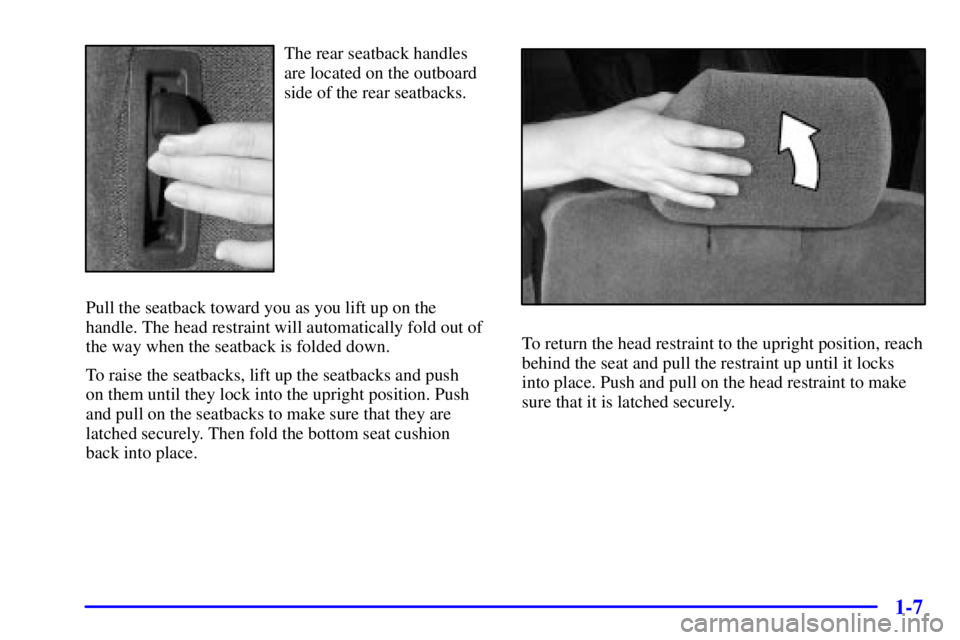
1-7
The rear seatback handles
are located on the outboard
side of the rear seatbacks.
Pull the seatback toward you as you lift up on the
handle. The head restraint will automatically fold out of
the way when the seatback is folded down.
To raise the seatbacks, lift up the seatbacks and push
on them until they lock into the upright position. Push
and pull on the seatbacks to make sure that they are
latched securely. Then fold the bottom seat cushion
back into place.
To return the head restraint to the upright position, reach
behind the seat and pull the restraint up until it locks
into place. Push and pull on the head restraint to make
sure that it is latched securely.
Page 19 of 429
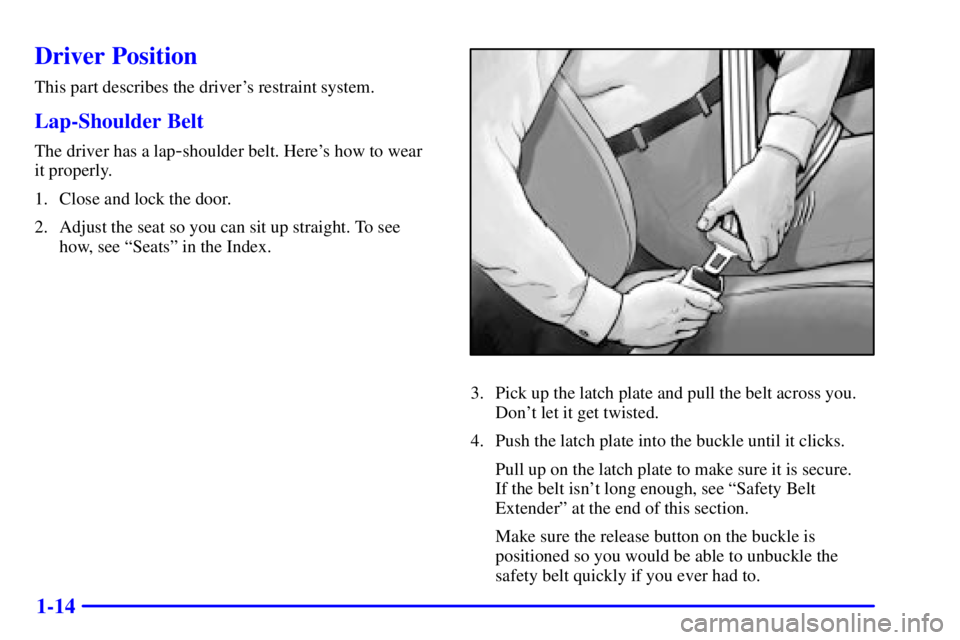
1-14
Driver Position
This part describes the driver's restraint system.
Lap-Shoulder Belt
The driver has a lap-shoulder belt. Here's how to wear
it properly.
1. Close and lock the door.
2. Adjust the seat so you can sit up straight. To see
how, see ªSeatsº in the Index.
3. Pick up the latch plate and pull the belt across you.
Don't let it get twisted.
4. Push the latch plate into the buckle until it clicks.
Pull up on the latch plate to make sure it is secure.
If the belt isn't long enough, see ªSafety Belt
Extenderº at the end of this section.
Make sure the release button on the buckle is
positioned so you would be able to unbuckle the
safety belt quickly if you ever had to.
Page 28 of 429
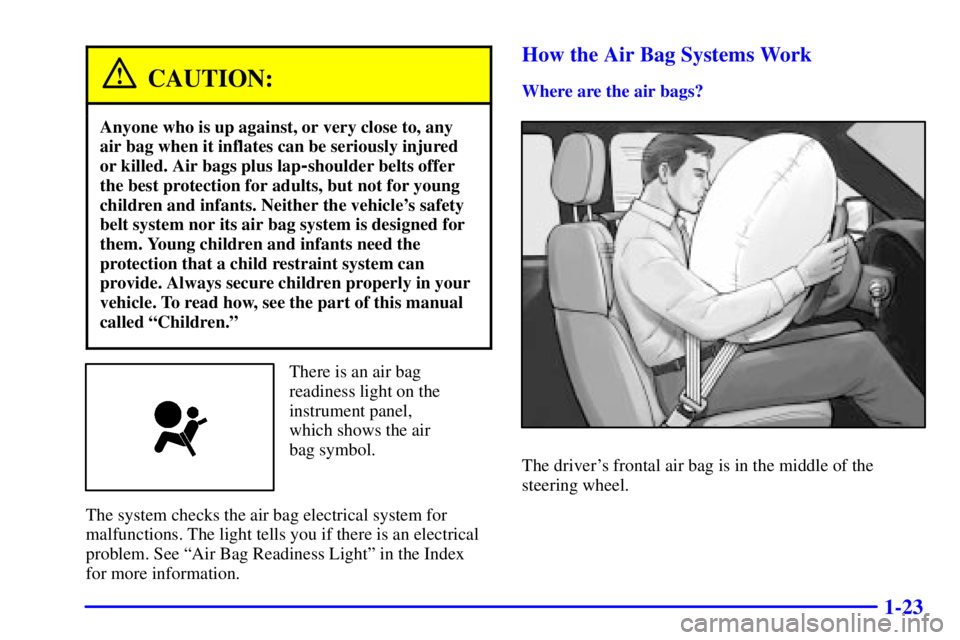
1-23
CAUTION:
Anyone who is up against, or very close to, any
air bag when it inflates can be seriously injured
or killed. Air bags plus lap
-shoulder belts offer
the best protection for adults, but not for young
children and infants. Neither the vehicle's safety
belt system nor its air bag system is designed for
them. Young children and infants need the
protection that a child restraint system can
provide. Always secure children properly in your
vehicle. To read how, see the part of this manual
called ªChildren.º
There is an air bag
readiness light on the
instrument panel,
which shows the air
bag symbol.
The system checks the air bag electrical system for
malfunctions. The light tells you if there is an electrical
problem. See ªAir Bag Readiness Lightº in the Index
for more information.
How the Air Bag Systems Work
Where are the air bags?
The driver's frontal air bag is in the middle of the
steering wheel.
Page 36 of 429
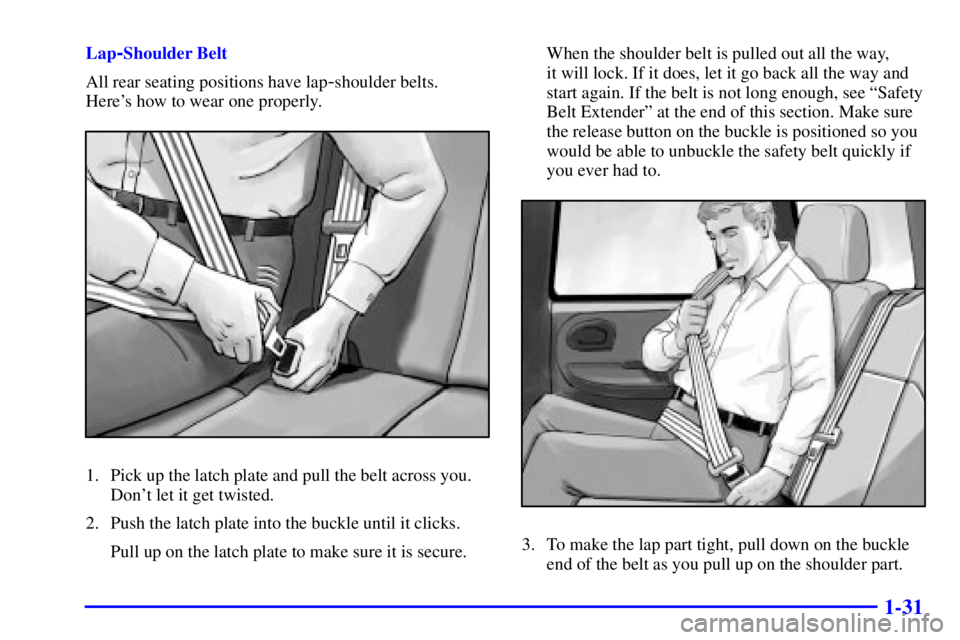
1-31
Lap-Shoulder Belt
All rear seating positions have lap
-shoulder belts.
Here's how to wear one properly.
1. Pick up the latch plate and pull the belt across you.
Don't let it get twisted.
2. Push the latch plate into the buckle until it clicks.
Pull up on the latch plate to make sure it is secure.When the shoulder belt is pulled out all the way,
it will lock. If it does, let it go back all the way and
start again. If the belt is not long enough, see ªSafety
Belt Extenderº at the end of this section. Make sure
the release button on the buckle is positioned so you
would be able to unbuckle the safety belt quickly if
you ever had to.
3. To make the lap part tight, pull down on the buckle
end of the belt as you pull up on the shoulder part.
Page 41 of 429
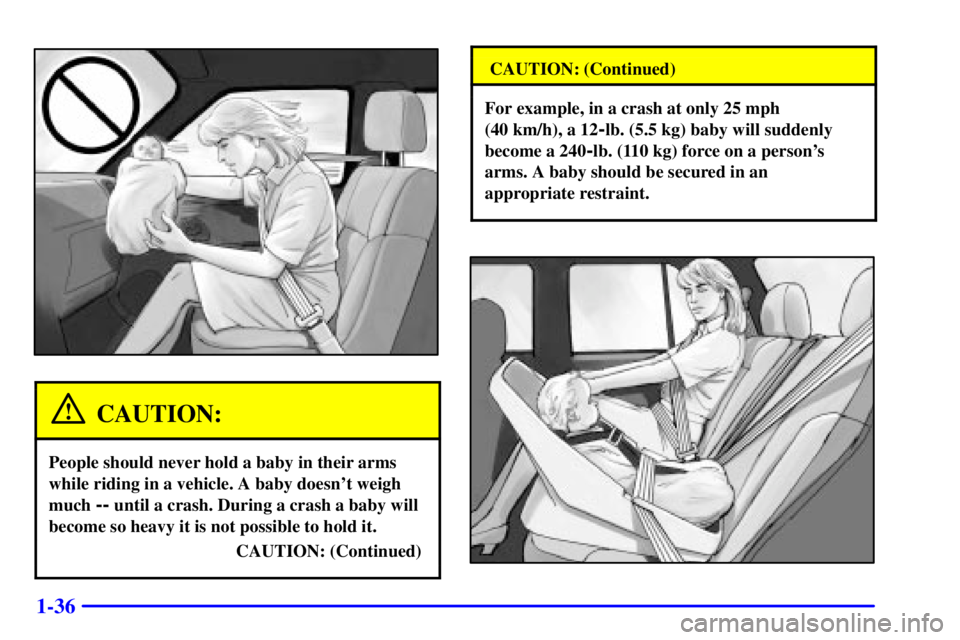
1-36
CAUTION:
People should never hold a baby in their arms
while riding in a vehicle. A baby doesn't weigh
much
-- until a crash. During a crash a baby will
become so heavy it is not possible to hold it.
CAUTION: (Continued)
CAUTION: (Continued)
For example, in a crash at only 25 mph
(40 km/h), a 12
-lb. (5.5 kg) baby will suddenly
become a 240
-lb. (110 kg) force on a person's
arms. A baby should be secured in an
appropriate restraint.
Page 43 of 429
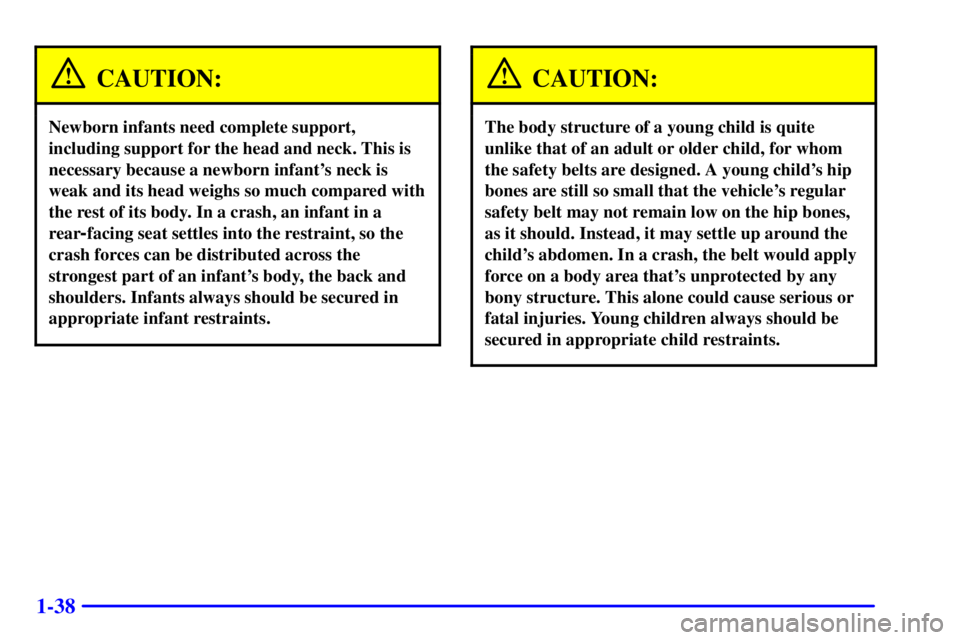
1-38
CAUTION:
Newborn infants need complete support,
including support for the head and neck. This is
necessary because a newborn infant's neck is
weak and its head weighs so much compared with
the rest of its body. In a crash, an infant in a
rear
-facing seat settles into the restraint, so the
crash forces can be distributed across the
strongest part of an infant's body, the back and
shoulders. Infants always should be secured in
appropriate infant restraints.
CAUTION:
The body structure of a young child is quite
unlike that of an adult or older child, for whom
the safety belts are designed. A young child's hip
bones are still so small that the vehicle's regular
safety belt may not remain low on the hip bones,
as it should. Instead, it may settle up around the
child's abdomen. In a crash, the belt would apply
force on a body area that's unprotected by any
bony structure. This alone could cause serious or
fatal injuries. Young children always should be
secured in appropriate child restraints.
Page 46 of 429
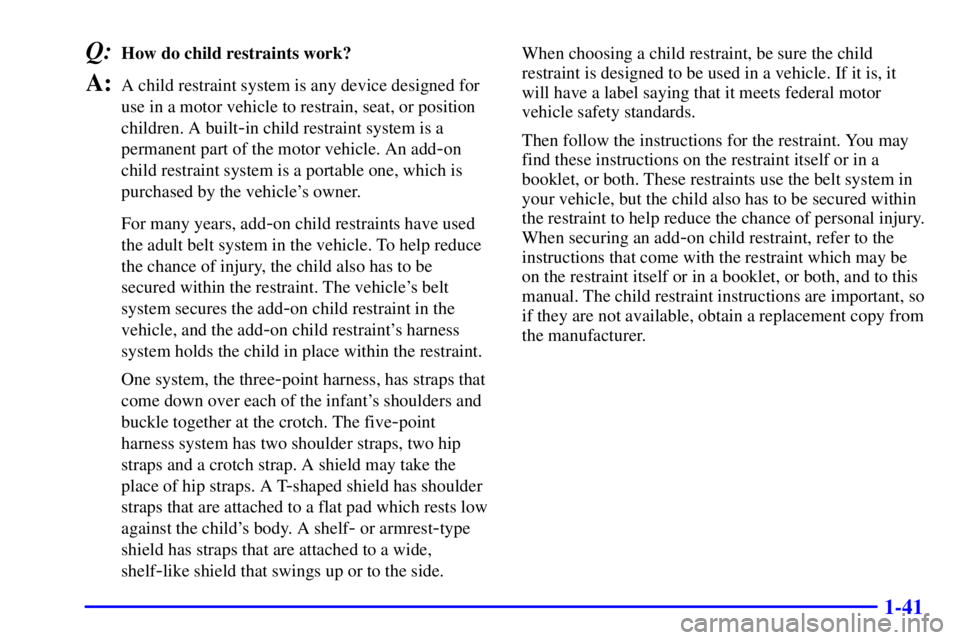
1-41
Q:How do child restraints work?
A:A child restraint system is any device designed for
use in a motor vehicle to restrain, seat, or position
children. A built
-in child restraint system is a
permanent part of the motor vehicle. An add
-on
child restraint system is a portable one, which is
purchased by the vehicle's owner.
For many years, add
-on child restraints have used
the adult belt system in the vehicle. To help reduce
the chance of injury, the child also has to be
secured within the restraint. The vehicle's belt
system secures the add
-on child restraint in the
vehicle, and the add
-on child restraint's harness
system holds the child in place within the restraint.
One system, the three
-point harness, has straps that
come down over each of the infant's shoulders and
buckle together at the crotch. The five
-point
harness system has two shoulder straps, two hip
straps and a crotch strap. A shield may take the
place of hip straps. A T
-shaped shield has shoulder
straps that are attached to a flat pad which rests low
against the child's body. A shelf
- or armrest-type
shield has straps that are attached to a wide,
shelf
-like shield that swings up or to the side.When choosing a child restraint, be sure the child
restraint is designed to be used in a vehicle. If it is, it
will have a label saying that it meets federal motor
vehicle safety standards.
Then follow the instructions for the restraint. You may
find these instructions on the restraint itself or in a
booklet, or both. These restraints use the belt system in
your vehicle, but the child also has to be secured within
the restraint to help reduce the chance of personal injury.
When securing an add
-on child restraint, refer to the
instructions that come with the restraint which may be
on the restraint itself or in a booklet, or both, and to this
manual. The child restraint instructions are important, so
if they are not available, obtain a replacement copy from
the manufacturer.
Page 47 of 429

1-42 Where to Put the Restraint
Accident statistics show that children are safer if they
are restrained in the rear rather than the front seat.
General Motors, therefore, recommends that child
restraints be secured in a rear seat outside position
including an infant riding in a rear
-facing infant seat, a
child riding in a forward
-facing child seat and an older
child riding in a booster seat. Never put a rear
-facing
child restraint in the front passenger seat. Here's why:
CAUTION:
A child in a rear-facing child restraint can be
seriously injured or killed if the right front
passenger's air bag inflates. This is because the
back of the rear
-facing child restraint would
be very close to the inflating air bag. Always
secure a rear
-facing child restraint in a rear seat
outside position.
You may secure a forward-facing child restraint
in the right front seat, but before you do, always
move the front passenger seat as far back as it
will go. It's better to secure the child restraint in
a rear seat outside position.
Wherever you install it, be sure to secure the child
restraint properly.
Keep in mind that an unsecured child restraint can move
around in a collision or sudden stop and injure people in
the vehicle. Be sure to properly secure any child
restraint in your vehicle
-- even when no child is in it.
Page 49 of 429
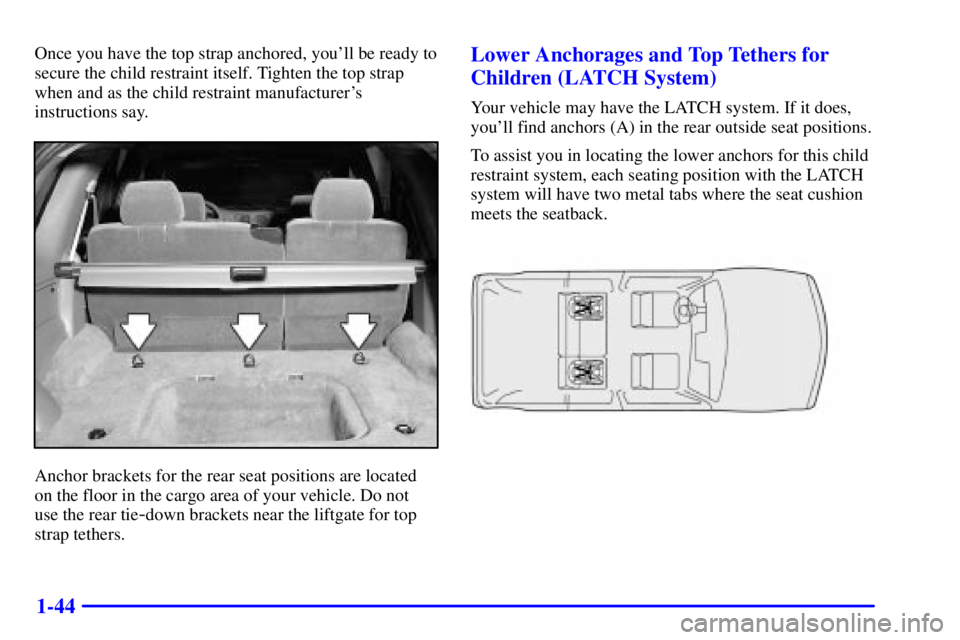
1-44
Once you have the top strap anchored, you'll be ready to
secure the child restraint itself. Tighten the top strap
when and as the child restraint manufacturer's
instructions say.
Anchor brackets for the rear seat positions are located
on the floor in the cargo area of your vehicle. Do not
use the rear tie
-down brackets near the liftgate for top
strap tethers.
Lower Anchorages and Top Tethers for
Children (LATCH System)
Your vehicle may have the LATCH system. If it does,
you'll find anchors (A) in the rear outside seat positions.
To assist you in locating the lower anchors for this child
restraint system, each seating position with the LATCH
system will have two metal tabs where the seat cushion
meets the seatback.
Page 51 of 429

1-46
With this system, use the LATCH system instead of the
vehicle's safety belts to secure a child restraint.
CAUTION:
If a LATCH-type child restraint isn't attached to
its anchorage points, the restraint won't be able
to protect a child sitting there. In a crash, the
child could be seriously injured or killed. Make
sure that a LATCH
-type child restraint is
properly installed using the anchorage points, or
use the vehicle's safety belts to secure the
restraint. See ªSecuring a Child Restraint in a
Rear Outside Seat Positionº in the Index for
information on how to secure a child restraint in
your vehicle using the vehicle's safety belts.